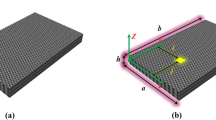Abstract
This paper considers intelligent diagnosis of structural cracks emanating from rows of rivet holes in thin metallic plates using active sensing network. Lamb waves are generated using actuators and propagate across the plates and received by sensors. We extract an effective feature called energy ratio change from time domain signals using wavelet transform. Then we develop neural networks using this feature to diagnose health condition. The sensing network is optimized by developing a mixed integer programming model. The results show that our method can effectively detect cracks and determine their locations, and the number of sensors of the sensing network can be significantly reduced while keeping high diagnostic accuracy. Important insights are also obtained such as in which area the sensing network has the weakest diagnostic capability.







Similar content being viewed by others
References
Abbate A, Koay J, Frankel J, Schroeder SC, Das P (1997) Signal detection and noise suppression using a wavelet transform signal processor: application to ultrasonic flaw detection. IEEE Trans Ultrason Ferroelectr Freq Control 44:14–26
Alleyne D, Cawley P (1992) The interaction of lamb waves with defects. IEEE Trans Ultrason Ferroelectr Freq Control 39:381–397
Alleyne DN, Cawley P (1992) Optimization of lamb wave inspection techniques. NDT E Int 25(1):11–22
Boller C (2001) Ways and options for aircraft structural health management. Smart Mater Struct 10(3):432
Bruant I, Gallimard L, Nikoukar S (2010) Optimal piezoelectric actuator and sensor location for active vibration control, using genetic algorithm. J Sound Vib 329(10):1615–1635
Chang ZS, Mal A (1999) Scattering of lamb waves from a rivet hole with edge cracks. Mech Mater 31:197–204
Frecker MI (2003) Recent advances in optimization of smart structures and actuators. J Intell Mater Syst Struct 14:207–216
Fromme P, Sayir MB (2002) Detection of cracks at rivet holes using guided waves. Ultrasonics 40:199–203
Ghosh T, Kundu T, Karpur P (1998) Efficient use of lamb modes for detecting defects in large plates. Ultrasonics 36:791–801
Grondel S, Delebarre C, Assaad J, Dupuis JP, Reithler L (2002) Fatigue crack monitoring of riveted aluminium strap joints by lamb wave analysis and acoustic emission measurement techniques. NDT E Int 35:137–146
Ihn JB, Chang FK (2004) Detection and monitoring of hidden fatigue crack growth using a built-in piezoelectric sensor/actuator network: I. diagnostics. Smart Mater Struct 13:609–620
Legendre S, Massicotte D, Goyette J, Bose TK (2000) Wavelet-transform-based method of analysis for lamb-wave ultrasonic NDE signals. IEEE Trans Instrum Meas 49:524–530
Liu SW, Huang JH, Sung JC, Lee CC (2002) Detection of cracks using neural networks and computational mechanics. Comput Methods Appl Mech Eng 191(25–26):2831–2845
Liu W, Gao WC, Sun Y, Xu MJ (2008) Optimal sensor placement for spatial lattice structure based on genetic algorithms. J Sound Vib 317:175–189
Lu Y, Ye L, Su Z, Yang C (2008) Quantitative assessment of through-thickness crack size based on lamb wave scattering in aluminium plates. NDT E Int 41:59–68
McNab A, Dunlop I (1995) A review of artificial intelligence applied to ultrasonic defect evaluation. Insight 37(1):11–16. Anglais
Mehrabian AR, Yousefi-Koma A (2011) A novel technique for optimal placement of piezoelectric actuators on smart structures. J Frankl Inst 348(1):12–23
Park S, Yun C-B, Roh Y (2007) Damage diagnostics on a welded zone of a steel truss member using an active sensing network system. NDT E Int 40:71–76
Staszewski W, Boller C, Tomlinson G (2004) Health monitoring of aerospace structures: smart sensor technologies and signal processing. Wiley, New York
Zgonc K, Achenbach JD (1996) A neural network for crack sizing trained by finite element calculations. NDT E Int 29:147–155
Author information
Authors and Affiliations
Corresponding author
Rights and permissions
About this article
Cite this article
Liu, S., Du, C. & Zhang, J. Intelligent diagnosis of structural cracks with optimized sensing network. Microsyst Technol 19, 1653–1660 (2013). https://doi.org/10.1007/s00542-013-1875-z
Received:
Accepted:
Published:
Issue Date:
DOI: https://doi.org/10.1007/s00542-013-1875-z




